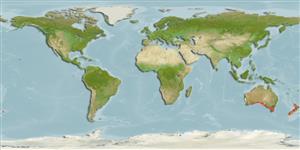>
Syngnathiformes (Pipefishes and seahorses) >
Syngnathidae (Pipefishes and seahorses) > Syngnathinae
Etymology: Hippocampus: Greek, ippos = horse + Greek,kampe = curvature (Ref. 45335).
Environment: milieu / climate zone / depth range / distribution range
экология
морской; солоноватоводный демерсальный; немигрирующий; пределы глубины 0 - 104 m (Ref. 52034). Temperate; 24°S - 50°S, 80°E - 120°W (Ref. 52034)
Southwest Pacific: Australia and New Zealand (Ref. 115213). Occurrence in Thailand and the Philippines (Ref. 43081) needs verification.
Length at first maturity / Size / Вес / Возраст
Maturity: Lm 8.7 range ? - ? cm
Max length : 35.0 cm OT самец/пол неопределен; (Ref. 6787); common length : 18.0 cm OT самец/пол неопределен; (Ref. 9003)
Краткое описание
определительные ключи | морфология | морфометрия
колючие лучи спинного плавника (общее число) : 0; членистые (мягкие) лучи спинного плавника (общее число) : 25 - 31; колючие лучи анального плавника: 0; членистые (мягкие) лучи анального плавника: 4.
Found in large rock pools at low tide. They remain motionless amidst seaweed. Juveniles are pelagic (Ref. 30915) or attached to drifting seaweeds (Ref. 31838). Feed on minute crustaceans (e.g. copepods and amphipods). Nocturnal (Ref. 9003). Ovoviviparous (Ref. 205). The male carries the eggs in a brood pouch which is found under the tail (Ref. 205). Seen in groups at night. Also around jetties and other man-made objects; attached to sponges and colonial hydroids in deeper water (Ref. 30915). Length measurements refer to height (= TL - head length).
This is the largest seahorse species in southeastern Australia, and has more dorsal fin rays and tail rings than any other seahorse (Ref. 31838). Sold locally and internationally for the aquarium trade (Ref. 31838). Dried and sold to the Oriental medicine trade as a tonic and aphrodisiac (Ref. 5316, 34026).
Several subsequent broods are carried by the male in a brood pouch during the spawning season. Do not obviously pair, as other seahorses do (Ref. 30915). Fertilised eggs deposited by females in the pouch of males are incubated for about four weeks before hatching (Ref. 31838). Hatching occurs at night, coinciding with full moon periods during summer months (Ref. 31838). Young emerge from the pouch and immediately rise to the surface where they grasp floating debris with their tail (Ref. 31838).
Lourie, S.A., R.A. Pollom and S.J. Foster, 2016. A global revision of the seahorses Hippocampus Rafinesque 1810 (Actinopterygii: Syngnathiformes): taxonomy and biogeography with recommendations for further research. Zootaxa 4146(1):1-66. (Ref. 115213)
Статус Красного Списка МСОП (Ref. 130435)
Угроза для людей
Harmless
Использование человеком
рыболовство: интереса не представляет; аквариум: коммерческий
дополнительная информация
инструменты
Специальные отчеты
Скачать в формате XML
ресурсы в Интернет
Estimates based on models
Preferred temperature (Ref.
123201): 14.1 - 19.8, mean 17 °C (based on 322 cells).
Phylogenetic diversity index (Ref.
82804): PD
50 = 0.5000 [Uniqueness, from 0.5 = low to 2.0 = high].
Bayesian length-weight: a=0.00447 (0.00177 - 0.01127), b=3.00 (2.78 - 3.22), in cm total length, based on LWR estimates for this (Sub)family-body shape (Ref.
93245).
Trophic level (Ref.
69278): 3.4 ±0.0 se; based on diet studies.
устойчивость к внешним воздействиям (Ref.
120179): высокий, минимальное время удвоения популяции до 15 месяцев (tm=1; Assuming annual Fec<1000).
Fishing Vulnerability (Ref.
59153): Low vulnerability (10 of 100).
Nutrients (Ref.
124155): Calcium = 61.4 [38.8, 114.6] mg/100g; Iron = 0.447 [0.279, 0.744] mg/100g; Protein = 17.8 [16.8, 18.9] %; Omega3 = 0.543 [0.315, 0.933] g/100g; Selenium = 15.8 [7.9, 37.3] μg/100g; VitaminA = 9.31 [3.19, 26.90] μg/100g; Zinc = 0.702 [0.518, 0.958] mg/100g (wet weight);
